FCV Business and Social Enterprises
D Williams
Summary
The FCV was established by the Forests Act 1918 to protect and manage Victoria’s public forests for the long term benefit of Victorians. The primary charter provided the framework for the FCV’s many and varied activities and works over almost seven decades. The Act also provided for the Commission to undertake secondary activities which were indirectly related to the primary purpose. These non-core activities included operating business and social enterprises and ‘war effort’ programs. They significantly contributed to the Commission’s work over it's life.
Business enterprises included timber seasoning, two sawmills, a eucalyptus oil distillery, a steel tramway, harvesting and directly selling forest products, and a one-off opportunistic export sale of hardwood poles. The primary objectives were specific to each business but the general purpose was either to:
- Provide leadership in a new area of forest products to encourage private companies to follow, or;
- Supplement overall production because of limited private sector capacity.
Commercial performance was a secondary objective with these businesses. Some of the businesses performed well financially including harvesting and directly selling forest products, eucalyptus oil production and one-off sale of export hardwood poles. The Erica sawmill was profitable until the latter stages of its life. The timber seasoning business returned a minor profit overall but was not a commercial success. The Erica tramway and Nayook sawmill were unsuccessful commercially.
The ‘war effort’ programs and social enterprises were not commercial businesses, and were instigated at the direction of the Victorian government. The ‘war effort’ programs of emergency firewood production for Melbourne and Geelong, and charcoal production, were both very successful. The social enterprises included 11 separate unemployment schemes and training programs. The Commission became adept at operating the unemployment schemes and became dependent of the labour to carry out much of its forest works programs. The training programs were partly successful with significant numbers of trainees subsequently gaining employment as a result of skills acquired under the programs.
Introduction
The FCV was established in 1918 under the Forests Act 1918. The principles for the new Department provided the framework for FCV core policies and practices. In addition there was provision for the FCV to enter into what could be considered non-core enterprises. This provided the basis for the FCV’s involvement in business enterprises, ‘war effort’ programs and social enterprises over the life of the Commission.
This paper reviews the nature, reasons for involvement, objectives and assessment of the success of the FCV’s non-core enterprises.
Background
The principles laid out in the Forests Act 1918 included the following:
- The conservation, development and utilisation of the indigenous forests, based on sound forestry principles.
- The establishment of adequate plantations of exotic softwood species.
- The prosecution of essential research work concerning the natural products of the forests.
- The need for an effective fire prevention and fire suppression organisation.
A new Act was adopted in 1958 expanded the provisions of the earlier Act.
The Act also provided for the Commission to enter into other non-core activities. These represented significant part of the Commission’s work over it's life.
The non-core enterprises and activities can be divided into two classes, viz:
- Business Enterprises– these were initiated by the Commission with the support of the Victorian Government. Whilst they were established as commercial businesses, financial objectives were secondary. Primary objectives varied between businesses, but the objectives were to encourage and assist advancement of existing or new areas, or stepping in when private sector capacity was considered too limited. In the former situations the Commission’s approach was to ‘show the way’ as encouragement for private sector involvement by advancing knowledge and demonstrating the commercial viability of the businesses.
- Social Enterprises and ‘War Effort’ Programs– these activities resulted from government directions to deliver government policies and initiatives. Funding was provided by Commonwealth and Victorian governments and there were no commercial imperatives other than delivering the works in a financially efficient manner, and providing effective work or delivery of services and goods.
Table 1. Business and Social Enterprises and ‘War Effort’ Programs
Enterprise/Program
Objectives
Business Enterprises
The FCV operated five substantial businesses over almost seven decades. They included timber seasoning, sawmilling, eucalyptus oil production, operating a steel tramway for transporting licensees’ sawn timber, and harvesting and direct selling of forest products. The timber seasoning business was operated for the longest period, 47 years, and the business of harvesting and directly selling forest products operated for the shorter period of 20 years. All businesses were successful, to a greater or lesser extent, in achieving their primary non-commercial objectives. The businesses were of mixed success financially, with harvesting and directly selling forest products being quite profitable whereas operating the steel tramway resulted in significant accumulated losses.
As these enterprises were initiated by the FCV, it is interesting to consider the reasons for their involvement. There were two basic reasons:
- Taking a lead for private enterprise to follow in the case of the timber seasoning works and eucalyptus oil production.
- Supplement inadequate private industry capacity in the case of the sawmills, the tramway and harvesting and directly selling forest products.
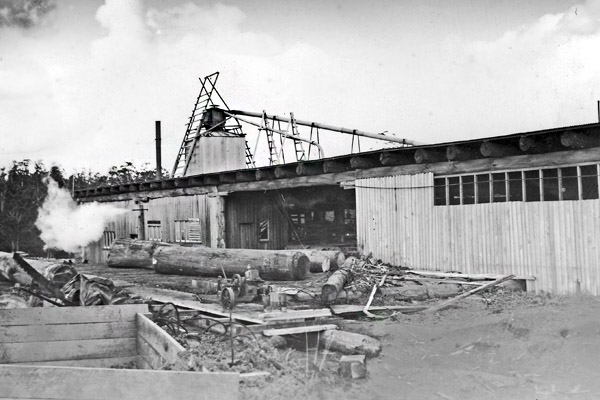
The State Sawmill at Erica
1946
Photo: JA McKinty
Source: M McKinty
Table 2. Summary of Business Enterprises & Level of Success
Business
Objectives
Timing
Success
First reported separately in the 1963/64 FCV Annual Report
‘War Effort’ Programs.
The Commission was directed to assist with the Government’s ‘war effort’ with two programs, those being producing emergency firewood and charcoal for fuel oil.
Emergency Firewood Program
This program required the FCV to rapidly organise infrastructure and operations to produce and distribute large quantities of firewood in Melbourne and Geelong in war time because there was a sudden shortage of coal and increased demand for power for heavy industry for the war effort. The program was a large scale complex task involving a number of external government and private parties with in-forest operations, establishment of wood depots in metropolitan areas, rail and road transport of long length wood from forests, sawing into short lengths at depots and distribution to users. The nature and scale of the task was well beyond anything previously experienced by the Commission. It involved engaging various sources of labour including direct employees, piece meal workers, contractors, aliens and European migrants and liaising with other Victorian and Commonwealth government departments, local municipal councils and government established emergency war time agencies as well as private businesses and contractors.
The program was very successful at producing and distributing firewood and overcoming many challenges in the process. Almost two million tons of firewood was produced at an expenditure of almost £3.5 million. The program was never meant to incorporate commercial objectives and accumulated losses amounted to £1.1 million. Some of the losses were recompensed from the Commonwealth government.
"The land on the eastern side of Kyle Road, which is no longer part of the North Altona site (in 2021 this facility was still being used by DELWP), was originally used for the purpose of a FCV firewood storage depot and workshop. It was called the Brookwood rail-siding, and was one of several firewood storage depots close to and in Melbourne, the others being in Toorak, Fitzroy and Kew. These firewood depots were a part of the FCV's post-WW2 involvement in supplying firewood to meet community needs. In December 1950 a large fire at this depot destroyed more than 3300 tonnes of firewood."
Charcoal Production
The six year involvement in charcoal production was to provide a substitute fuel for motor vehicles caused by war time with the restrictions of supplies of imported petrol. It stemmed from direction from the Substitute Fuels of State Emergency Council for Civic Defence. Private enterprise was unable and/or didn’t initially respond to the need to increase charcoal production. The Commission formed the State Charcoal Branch to organise increased production, build up reserves to meet emergencies and regulate the cost to consumers.
The task was successfully achieved such that by 1943 there was sufficient volume to satisfy essential transport requirements. Production and distribution were steady by that time and private enterprise was able to cope with normal demands. The program incurred total costs of £275,000 and accumulated losses of almost £50,000.
FCV Annual Report Extracts
“... the Commission in March last formed the State Charcoal Branch to organize increased production of charcoal, to build up reserves to meet emergencies and to regulate the cost to consumers.”
“Producers were circularized and asked to step up production to the limit, with any assistance which the Branch could extend.”
“Practical instructions and advice regarding the most economical methods of production were incorporated in a leaflet published and distributed to prospective new burners.”
“As a result of the publicity, information and assistance distributed by the Branch, and by personal contact of Commission officers with both existing and prospective producers, rapid improvement in the supply position soon became apparent. At the close of the financial year, not only were current demands being met but also it was possible to make a commencement with the creation of reserve stocks.”
“Installation of departmental kilns and grading plants was continued, and at the date of this Report 221 kilns and 12 pits were in operation, the maximum fortnightly production being just short of 600 tons.” Source: All above from FCV Annual Report, 1942/43
“Charcoal production and distribution are on a reasonably stable basis, and private enterprise is now able to cope with all ordinary demands. This state of affairs should continue provided that adequate manpower is left available to the industry, particularly in those country districts from which charcoal supplies are drawn.” Source: FCV Annual Report, 1943/44
Production (tons)
1940/41 - 1650
1942/43 - 38922
1944/45 - 14358
1946/47 - 687
Source: FCV Annual Reports
See Also
The Manufacture of Wood Charcoal. FCV 1941 & 1942
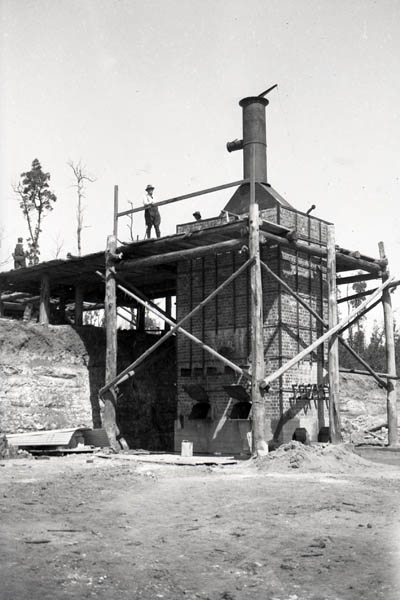
The FCV constructing Kurth Kiln
A facility to expand charcoal production during WW II
About 1941
Source: FCRPA
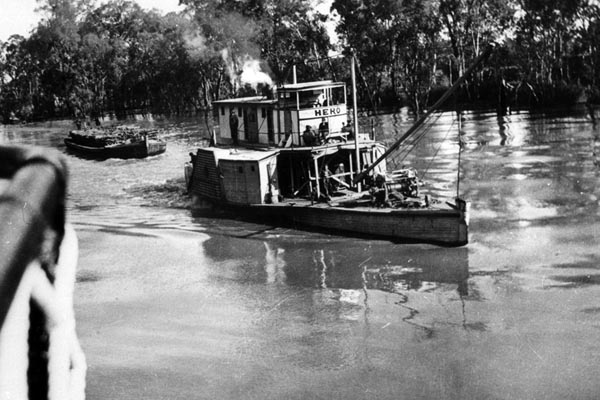
The FCV paddle steamer "Hero" towing firewood on the Murray River as part of the "War Effort" Emergency Firewood Program
About 1943
Source: FCRPA
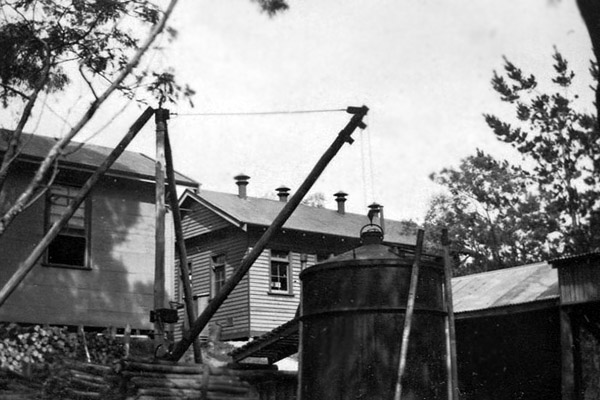
The FCV was already producing charcoal at the VSF in 1940 - kiln below the Chemistry & Physic Labs
1940
Source: G Cleary
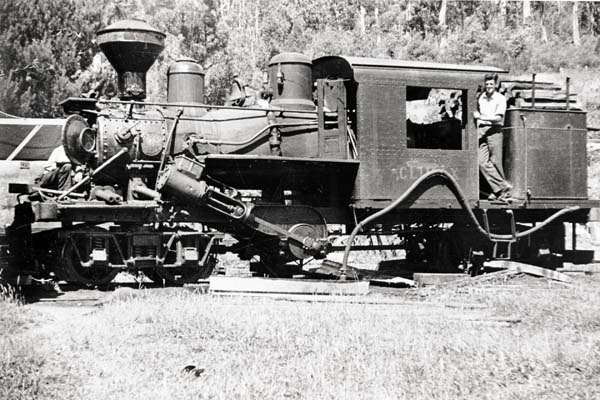
The FCV-owned Climax (Builders Number 1694) at Tyers Junction near Erica
About 1948
Source: FCRPA
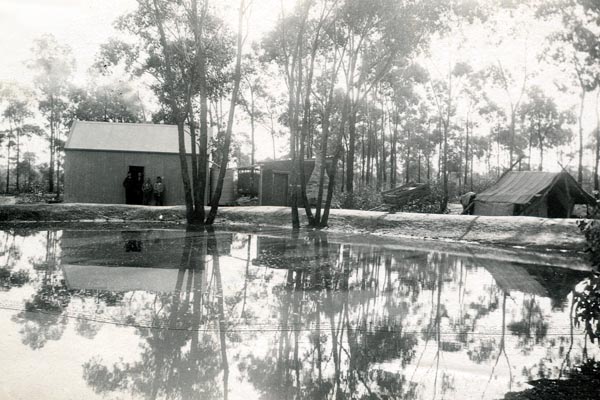
FCV Eucalypt oil distillery at Wellsford
1928
Photo: EJ Semmens
Source: FCRPA
Social Enterprises
There were 11 separate schemes for unemployment relief and training stretching over more than 5 decades from 1927. The unemployment relief schemes were aimed at providing relief for unemployed men during depressed economic periods. The training programs targeted younger people with the aim of improving work and life skills to increase the opportunities to secure worthwhile employment.
The FCV was particularly well placed to operate the schemes. The advantages enjoyed by the Commission included ability to quickly devise effective work programs, effectively direct and supervise such work, the tasks were overwhelmingly labour intensive, the work locations were spread across Victoria, forest camps were quickly established to provide accommodation for the earlier schemes and workers generally found the working and living conditions agreeable. The schemes were funded predominantly by the Commonwealth government with funding for some schemes from the Victorian government and from private benefactors in the case of one of the youth training programs.
The Commission became quite adept at establishing and successfully delivering the schemes. All the unemployment relief schemes were successful in meeting the objectives of providing relief for unemployed men. Many thousands of unemployed men were provided relief under the schemes over the years. More than $17 million were spent on the schemes most of which was paid as wages. The training programs were successful to varying extents in providing improved work and life skills and a good proportion of participants subsequently secured worthwhile employment as a result of the training.
The tasks involved silvicultural works, establishment and maintenance of plantations, fire protection, road and track maintenance, nursery works and work on recreational facilities in the latter period. There was limited activity in construction and maintenance of buildings and facilities. The work was of lasting value and was generally of a reasonable or high quality. The Commission came to rely on this source of labour for its forest works program over a period of years.
Table 3. Unemployment and Training Schemes Operated by the FCV
Scheme
Objectives
Period of Operation
Conclusion
The Commission was established with a core charter to protect and manage Victoria’s public forests for the long term benefit of Victorians. This involved a many varied activities that were directly linked to the core charter. The Commission was also able to undertake other enterprises which could be described as non-core. These included business enterprises, ‘war effort’ programs and social programs. The Commission inherited a major operating timber seasoning business at the time it was established. It continued this business for a further almost four decades and actively entered into a number of other businesses and social enterprises including ‘war effort’ programs. This non-core activity was significant and long lasting.
The businesses were initiated by the Commission with Victorian government support and included sawmills, eucalyptus oil, production, a tramway for transporting licensees’ timber and harvesting and directly selling forest products, as well as the inherited timber seasoning works. Some of the businesses were commenced to provide a lead for private enterprises to follow and others were to supplement inadequate private sector capacity at the time. All were successful in achieving their non-financial objectives but financial performance was varied. Some businesses, including harvesting and direct selling forest produce, eucalyptus oil production and Erica sawmill performed reasonably well financially, at least for substantial periods. Erica tramway and Nayook sawmill performed poorly financially.
The ‘war effort’ programs of emergency firewood production and charcoal production were very successful in assisting in the overall ‘war effort’. The emergency firewood program was large scale and was established quickly. The program was complex involving liaising and coordinating with many external organisations and carrying out new tasks. It was of a complexity and scale not previously experienced by the Commission.
There were 11 separate unemployment and training schemes successfully delivered by the Commission over a long period. The FCV was particularly well placed to provide the schemes with an ability to quickly devise effective work programs, effectively direct and supervise such work, the tasks were labour intensive resulting in most of the expenditure being paid as wages, the work locations were spread across Victoria, forest camps were quickly established to provide accommodation for the earlier schemes and workers generally found the working and living conditions agreeable.
The training programs were aimed at providing young people with improved work and life skills to increase opportunities of securing worthwhile employment. The programs were moderately successful resulting in significant numbers of participants subsequently securing employment.
Non-core businesses and social programs were actively pursued by the Commission over the full period of the Commission’s life. They were significant part and enhanced the overall work of the Commission and were successful to varying degrees.
